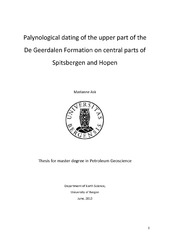| dc.description.abstract | The Late Triassic is the most problematic period in terms of resolution and age control. The period spans about 36 million years and consists of three stages - Carnian, Norian and Rhaetian. Only four clusters of radiometric age constrain the Triassic time scale (Ogg et al., 2012), and macrofossil data are scarce, hampering exact age determination and biostratigraphic correlation. Additional knowledge on the stratigraphy and geographic ranges of different fossil groups are therefore crucial to build a better framework and thereby contribute in increasing the database. In the Barents Sea area, a huge delta complex reached Eastern Svalbard and Hopen by the end of Late Carnian, and by the end of Late Triassic the paralic deposits had prograded over the northwestern part of the Svalbard Archipelago. Shales, siltstones and sandstones of various thicknesses alternate in the De Geerdalen, Flatsalen and Svenskøya formations, reflecting the deltaic sediments deposited during this period (Riis et al., 2008). Previous studies regarding age datings from Hopen have been conflicting, and a lot of uncertainty is related to the location of the prograding deltafront at any time during this period. Palynological work from two sections, located at Lyngefjellet northeast on Hopen, and from Deltaneset, Central Spitsbergen, resulted in recognition of three assemblages of Late Carnian to ?Middle Norian age. The palynological assemblages are based on spores, pollen, acritarchs and other palynomorphs, and correlation to published records from the Barents Sea area and Arctic Canada have been used for age determination. The lower part of the De Geerdalen Formation section on Hopen is assigned a Late Carnian age based on palynological assemblages similar to the palynofloras recorded in the Barents Sea area and Arctic Canada, and is believed deposited in a deltaic setting reflected in a palynoflora from typical wetland plants. For the upper part of the formation, Early Norian has been suggested based on resemblances to assemblages from the overlying ammonite dated (Korchinskaya, 1982) Flatsalen Formation. The upper section of the De Geerdalen Formation belongs to the Hopen member (Solvi, 2013), herein documented to be equivalent to the Isfjorden Member on Deltaneset, Central Spitsbergen. A coastal environment, probably a delta setting, is suggested for these sections. Svenskøya Formation overlays the Flatsalen Formation and an Early to Middle Norian age is suggested based on the stratigraphically limited taxa, and a delta-setting environment is proposed. | en_US |
